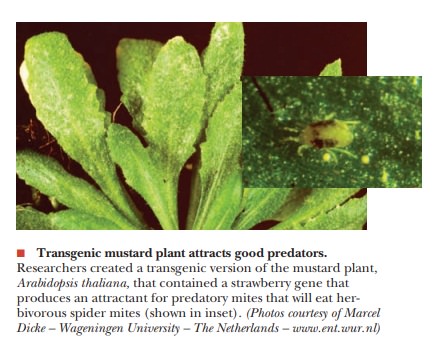Chapter: Biochemistry: Nucleic Acid Biotechnology
Genetic Engineering in Agriculture
Genetic Engineering in
Agriculture
The idea
of genetic engineering in humans often upsets people because they are fearful
of “playing God.” Genetic manipulations in plants appear to cause less
controversy, although many people are still concerned about the practice.
Nevertheless, many types of modifications have been made, and some have been
introduced with little fanfare and have shown some signs of success. Several
examples are listed here. It is important to realize that many of the
modifications that have been made using genetic engineering are just controlled
versions of the selective breeding used for centuries to improve crop and
animal production.
Disease resistance. Because most high-production crops
involvespecialized strains, many are more susceptible to fungal disease and
insect damage. As a consequence, many herbicides and insec-ticides are applied
liberally during the growing season. In many cases, other plants have natural
resistance to these pests. When the gene that produces the resistance can be
isolated, it can be transferred into other plants. There has been limited
success in transferring such resistance to crop species. In 2000, the public became
more aware of genetically modified (GM) food crops because of news about Bt
corn, a crop carrying a bacterial gene that produces a toxin poisonous to
certain caterpillars. The Bt gene, from Bacillus
thuringensis, has been put into corn and cot-ton to increase crop yields by
killing the caterpillars that would otherwise eat those crops. It also reduces
the amount of pesticides needed to grow the crops. On the negative side is the
poten-tial harm to other species. For example, environmental groups oppose the
planting of Bt corn because of its effect on the mon-arch butterfly in lab
tests.

Nitrogen fixation. Nitrogen fixation is most easily accomplished
bybacteria that grow in nodules on the roots of certain legumes, such as beans,
peas, and alfalfa. We now realize that the genes of the nitrogen-fixing
bacteria actually become shared with the genes of the host plant. Much research
is going on to determine whether these genes could be incorporated into other
plants, which would reduce the amount of nitrogen fertilizer needed for maximal
plant growth and crop production.
Frost-free plants. Many marine organisms, such as fish found inthe
Antarctic, produce a so-called antifreeze protein, a pro-tein characterized by
its hydrophobic surface, which prevents the formation of ice crystals at low
temperature. In plants exposed to freezing temperatures, ice crystals in their
tissues actually cause the frost damage. Insertion of the gene for the
antifreeze protein into strawberries and potatoes, for exam-ple, has resulted
in crops that are stable during late spring frost or in areas with very short
growing seasons. Much con-troversy has ensued over these crops because, in each
case, a foreign gene from a nonplant species was introduced into a plant. This
type of cross-species gene modification causes widespread concern, even though
the taste and texture of the modified product is indistinguishable from those
of foods produced by unmodified plants.
Tomatoes with a long shelf life. The
Flavr Savr tomato has agenetic modification, but one in which no new gene has
been introduced. Rather, one of the plant’s own genes has been deactivated. The
gene in question is the one that allows the tomato plant to produce ethylene, a
key compound in the ripening process. Because this gene has been deactivated,
the tomatoes mature on the plant until they just begin to show some pink color-the
exact stage at which tomatoes are picked and sent to market. Typically, fields
of unmodified tomatoes need to be picked as many as nine times in a sea-son,
because the tomatoes all ripen at different rates. When an unmodified tomato
ripens, it continues to make ethylene, which leads to overripening, softening,
and deterioration. Fields of the modified tomatoes can be picked once or twice,
and the harvested fruits can be made to ripen as needed by exposing them to
exogenous ethylene gas. Because the Flavr Savr tomato does not make its own
ethylene, the shelf life of the ripe, ready-to-eat tomato is increased. The
financial sav-ing made possible by less time spent picking tomatoes and the
extended shelf life results in a cheaper and better product. Best of all, the
taste is indistinguishable from that of unmodi-fied tomatoes.
Increased milk production. Much controversy exists over
provid-ing cows with supplemental bovine somatotropin (BST), also called growth
hormone, a hormone that increases metabolism and milk production in dairy cows.
The controversy centers on human consumption of the hormone. However, BST is a
pep-tide hormone, so it is hydrolyzed in the digestive tract and is not
absorbed directly into the human bloodstream. Furthermore, all milk must
contain some of this hor-mone, because the cow cannot produce milk without it.
A more soundly based concern about BST supplementation in dairy cows is that the
cows given extra BST often develop mastitis, an inflammation of the udder
caused by bacterial infection. Masti-tis is frequently treated with high doses
of antibiotics, and some of these antibiotics could end up in the milk, causing
problems for people with certain food sensitivity.
Good predator attraction. Researchers in the
Netherlands werestudying the mustard plant, Arabidopsis
thaliana, which is very susceptible to attack by herbivorous spider mite
predators. They introduced a strawberry gene into the mustard plants that
produces a chemical attractant for predatory mites that eat the herbivorous
spider mites.
Related Topics